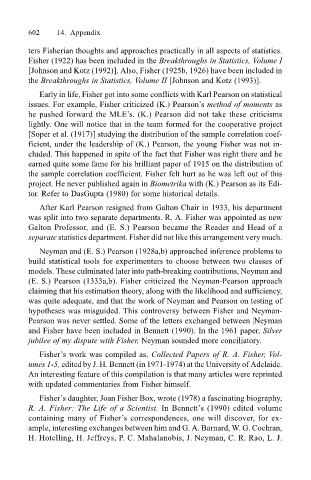Page 625 - Probability and Statistical Inference
P. 625
602 14. Appendix
ters Fisherian thoughts and approaches practically in all aspects of statistics.
Fisher (1922) has been included in the Breakthroughs in Statistics, Volume I
[Johnson and Kotz (1992)]. Also, Fisher (1925b, 1926) have been included in
the Breakthroughs in Statistics, Volume II [Johnson and Kotz (1993)].
Early in life, Fisher got into some conflicts with Karl Pearson on statistical
issues. For example, Fisher criticized (K.) Pearsons method of moments as
he pushed forward the MLEs. (K.) Pearson did not take these criticisms
lightly. One will notice that in the team formed for the cooperative project
[Soper et al. (1917)] studying the distribution of the sample correlation coef-
ficient, under the leadership of (K.) Pearson, the young Fisher was not in-
cluded. This happened in spite of the fact that Fisher was right there and he
earned quite some fame for his brilliant paper of 1915 on the distribution of
the sample correlation coefficient. Fisher felt hurt as he was left out of this
project. He never published again in Biometrika with (K.) Pearson as its Edi-
tor. Refer to DasGupta (1980) for some historical details.
After Karl Pearson resigned from Galton Chair in 1933, his department
was split into two separate departments. R. A. Fisher was appointed as new
Galton Professor, and (E. S.) Pearson became the Reader and Head of a
separate statistics department. Fisher did not like this arrangement very much.
Neyman and (E. S.) Pearson (1928a,b) approached inference problems to
build statistical tools for experimenters to choose between two classes of
models. These culminated later into path-breaking contributions, Neyman and
(E. S.) Pearson (1333a,b). Fisher criticized the Neyman-Pearson approach
claiming that his estimation theory, along with the likelihood and sufficiency,
was quite adequate, and that the work of Neyman and Pearson on testing of
hypotheses was misguided. This controversy between Fisher and Neyman-
Pearson was never settled. Some of the letters exchanged between |Neyman
and Fisher have been included in Bennett (1990). In the 1961 paper, Silver
jubilee of my dispute with Fisher, Neyman sounded more conciliatory.
Fishers work was compiled as, Collected Papers of R. A. Fisher, Vol-
umes 1-5, edited by J. H. Bennett (in 1971-1974) at the University of Adelaide.
An interesting feature of this compilation is that many articles were reprinted
with updated commentaries from Fisher himself.
Fishers daughter, Joan Fisher Box, wrote (1978) a fascinating biography,
R. A. Fisher: The Life of a Scientist. In Bennetts (1990) edited volume
containing many of Fishers correspondences, one will discover, for ex-
ample, interesting exchanges between him and G. A. Barnard, W. G. Cochran,
H. Hotelling, H. Jeffreys, P. C. Mahalanobis, J. Neyman, C. R. Rao, L. J.

